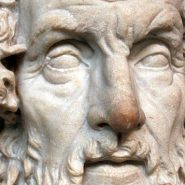By Andrew Marvell
Had we but world enough, and time,
This coyness, lady, were no crime.
We would sit down and think which way
To walk, and pass our long love’s day.
Thou by the Indian Ganges’ side
Shouldst rubies find; I by the tide
Of Humber would complain. I would
Love you ten years before the Flood,
And you should, if you please, refuse
Till the conversion of the Jews.
My vegetable love should grow
Vaster than empires, and more slow;
An hundred years should go to praise
Thine eyes, and on thy forehead gaze;
Two hundred to adore each breast,
But thirty thousand to the rest;
An age at least to every part,
And the last age should show your heart;
For, lady, you deserve this state,
Nor would I love at lower rate.
But at my back I always hear
Time’s wingèd chariot hurrying near;
And yonder all before us lie
Deserts of vast eternity.
Thy beauty shall no more be found,
Nor, in thy marble vault, shall sound
My echoing song; then worms shall try
That long-preserved virginity,
And your quaint honor turn to dust,
And into ashes all my lust;
The grave’s a fine and private place,
But none, I think, do there embrace.
Now therefore, while the youthful hue
Sits on thy skin like morning dew,
And while thy willing soul transpires
At every pore with instant fires,
Now let us sport us while we may;
And now, like amorous birds of prey,
Rather at once our time devour
Than languish in his slow-chapped power.
Let us roll all our strength, and all
Our sweetness, up into one ball;
And tear our pleasures with rough strife
Through the iron gates of life;
Thus, though we cannot make our sun
Stand still, yet we will make him run.
Originally published posthumously in Miscellaneous Poems (1681) by Andrew Marvell. Public domain.
Analysis
Andrew Marvell’s “To His Coy Mistress” is one of the finest examples of metaphysical poetry, blending intellectual wit, sensual persuasion, and philosophical depth. The poem dramatizes a lover’s argument for seizing the moment, as he urges his mistress to overcome her shyness and embrace passion before time and death intervene. Beneath the surface of seduction lies a profound meditation on the brevity of life and the futility of hesitation.
The Three-Part Structure
The poem unfolds in three distinct movements: if, but, and now.
- The first section imagines an ideal world “with world enough, and time” — a fantasy of eternal courtship and boundless patience.
- The second introduces stark reality: the relentless approach of death, symbolized by “Time’s wingèd chariot.”
- The final section converts awareness into action, urging the lovers to compress eternity into an instant of shared intensity.
This progression mirrors both logical persuasion and emotional escalation, turning philosophy into passion.
Imagery and Metaphysical Conceit
Marvell employs vivid and often startling imagery: the “vegetable love” that grows slowly and boundlessly; the “amorous birds of prey” consuming time through desire; and the “iron gates of life” symbolizing mortality’s barrier. These metaphysical conceits — imaginative comparisons drawn from science, theology, and nature — heighten the poem’s intellectual energy while amplifying its sensual urgency.
Time as the Great Antagonist
Unlike the romantic idealists of later centuries, Marvell’s speaker views time not as gentle but as predatory. The image of “Time’s wingèd chariot” captures both fear and fascination. Death is not a distant abstraction but an imminent pursuer. The poet’s urgency is therefore existential, not merely erotic: to love now is to defy annihilation.
The Carpe Diem Philosophy
In tone and theme, Marvell’s poem aligns with Robert Herrick’s “To the Virgins, to Make Much of Time.” Both implore youth to act before beauty fades. Yet Marvell’s approach is darker and more complex — his argument grounded not in pastoral simplicity but in metaphysical paradox. Passion becomes a rebellion against time itself, an assertion of human vitality against the void.
Style and Legacy
Marvell’s mastery lies in his fusion of logic and lyricism. The poem’s rhyming couplets move with controlled rhythm, balancing wit with emotional crescendo. It exemplifies the Cavalier and Metaphysical blend: urbane yet intense, playful yet profound.
“To His Coy Mistress” endures because it captures a truth both timeless and urgent — that love, to have meaning, must be lived fully within the confines of mortality.
